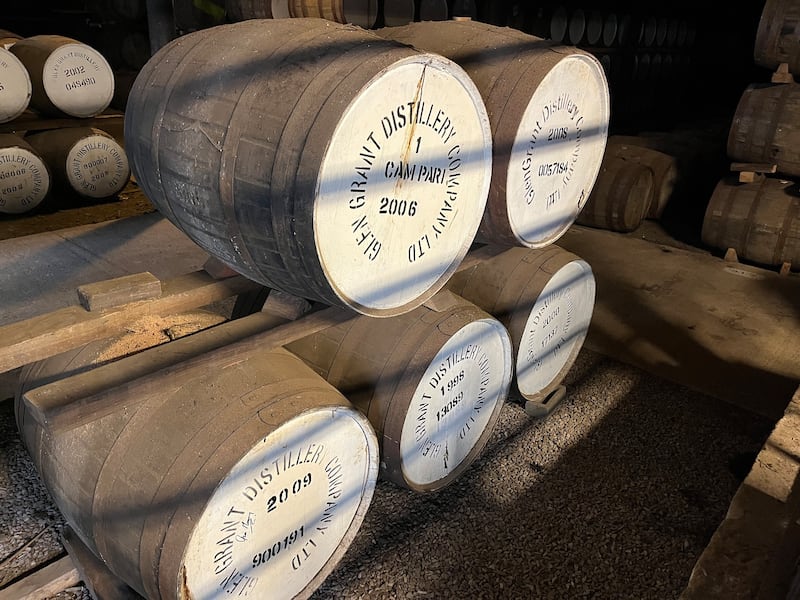The plan is to learn about the post-Covid surge in Scotch exports by visiting Glenfiddich distillery in Dufftown, Scotland’s “whisky capital of the world”. The seagulls have other ideas.
Several are flitting noisily around a warehouse roof beside the visitor centre. This seems strange: Glenfiddich is 40km inland amid rolling Scottish hills. That doesn’t stop seagulls from acting like they own the place.
Two of the gulls break away from the rest as I stroll past. I look up and lock eyes with one. “Angry Birds” is no longer just a computer game. The gull, eyes ablaze, is venting fury at me with a pal not terribly far above my head. “Nice seagulls,” I whisper nervously as I back along the path, afraid to take my eyes off them.
Suddenly, the bolshie birds swoop. Startled, I scream profanities and wave my arms about like a lunatic. My delirious tirade forces them to relent, so I make a dash for it. I look back to find they have resumed their attack. They are now chasing me at head height – two squawking, feathered missiles gaining fast on the back of my head.
READ MORE
The village, home to seven distilleries including Glenfiddich, has charm, but its centre looks tired. Many houses are for sale
Not knowing what else to do, I resume the crazy shouting dance. The only other person nearby, a man I assume is a tourist from Asia, must be wondering what on earth he is witnessing. The gulls back off and I find sanctuary in the visitor centre, bursting through its door.
Two young women behind the desk look at me and then at each other. Then they look back at me. “What is with those seagulls outside?” I pant. “We think they’re nesting in the warehouse roof,” shrugs one of the women. “It’s making them a bit chippy. I wouldn’t take it personally.”
This would be the place to order a stiff drink if only for the fact I am driving.
My arrival in Dufftown the previous evening was less eventful. Scotland’s “whisky trail” meanders through several villages and distilleries in this gorgeous corner of Moray along the hinterland of the Spey river. Scotch exports breached a record £6 billion (€6.9 billion) last year, as Asians replaced Europeans as the biggest buyers post Brexit.
Scotland’s famous spirit is on the up. Tourism is getting back in swing. So where is everybody?
[ Whisky expert suggests Scotch may not have been invented by the ScotsOpens in new window ]
Dufftown, the supposed whisky capital, is deserted heading into the British bank holiday weekend at the end of May. Maybe the seagulls have driven them all away. My only companions on a village stroll past 7pm on a Friday night are a flock of crows getting ready for bed. In hindsight this might be where the birds theme started. Dufftown has an Alfred Hitchcock-movie feel.
The village, home to seven distilleries including Glenfiddich, has charm, but its centre looks tired. Many houses are for sale. So is the Fournet Guest House and Noah’s Bistro on Balvenie Street thoroughfare leading to the clocktower. The butchers is for sale, as is the shuttered Stuart Arms bar and restaurant nearby. The Fife Arms looks deserted, too.
The shuttered DJ Chippie has two landlord’s signs on its window. One makes claims about the non-payment of rent, while the other says: “Due to TIME WASTERS, this whole property is back on the market.”

Scotch sales might be booming, but Dufftown clearly isn’t cashing in just yet. Perhaps things will pick up later in the season.
Next morning, after escaping the gulls of Glenfiddich, I head for the plush Macallan distillery on a rolling estate near Aberlour. I am met at the gate by a friendly man in a tartan suit holding a clipboard. He has emerged from a Bentley parked nearby. He asks if I have a reservation to visit. I haven’t, so he kindly offers to let me “drive the loop” to look around.
“Busy with visitors?” I ask.
“Overrun,” he says, explaining the appointments policy.
Beyond the gate on Macallan’s lush grounds, several high-end cars and executive minibuses are in the car park. I spin down to another famous estate distillery, The Glenlivet in Ballindollach. Inside its darkened bar and gift shop, wealthy-looking US tourists listen to cool lounge music.
Eventually, I double back to the more homely Glen Grant estate in Rothes. I get a very interesting tour of the manufacturing facilities from a young woman whose expert knowledge of whisky is a marvel, given she looks barely old enough to have much experience of drinking the stuff herself.
I ask another woman in the visitor centre why the businesses in the local villages, and especially Dufftown, are so quiet when clearly there are high-end whisky tourists about. She says most get chauffeured in and out these days from hotels in Inverness or Aberdeen. “It’s a pity they don’t stay in the local area,” she muses. A shame indeed.
I leave Glen Grant and, having checked the sky for seagulls, get into my car and head for the airport, and home.














